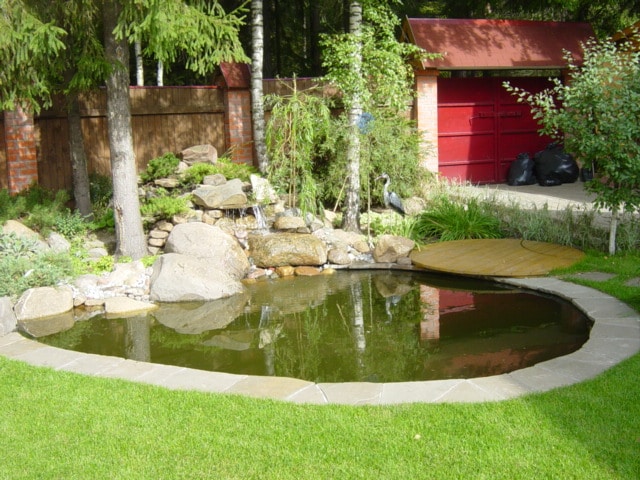
The pearl of the summer cottage is a pond. It adorns a relaxation area, pleases the eye, gives peace. For the construction of a pond, you can contact landscape designers, or you can build a pond on your own. Let's figure out together how best to build a pond with your own hands.
Content
Classification of artificial ponds
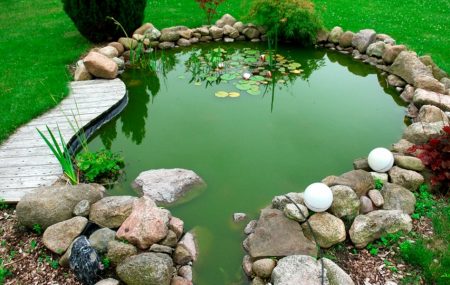
By size and purpose, all the ponds can be divided into four types:
- miniature. These ponds are used to decorate landscape design; they are easily made from improvised materials: bathtubs, basins, tires;
- decorative pond. As a rule, it is a beautiful pond decorated with aquatic plants. Around it is built a recreation area on the site;
- water. It performs both decorative and utilitarian functions and serves to grow and breed fish in the area. The depth of the reservoir is 1.5-2 meters;
- swimming pool. Serves for swimming. The size and shape of the pool depend only on the imagination and financial capabilities of the gardener.
Choosing a place for the pond
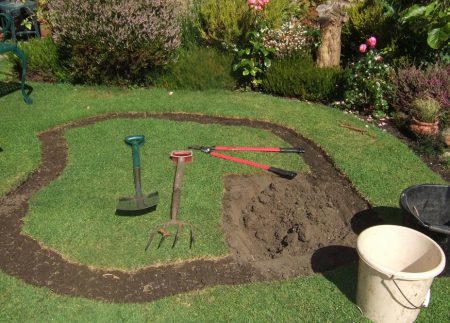
Before starting construction, you must choose a place to place the reservoir. When choosing a site for a future body of water, the following conditions must be met:
- The pond should fit seamlessly into the surrounding landscape.
- The pond should be located away from the crowns of tall trees, because the powerful roots of the trees can damage the bottom of the pond, and the foliage that has fallen into the water pollutes the water.
- It is optimal to place the pond in a place where most of the daylight hours it will be in light partial shade. Direct sunlight not only evaporates water, but also contributes to the active growth of algae and water damage.
- There should be sufficient space around the pond for the track. The absence of a track will complicate the maintenance of the reservoir.
- The pond is best located on the flat part of the site. If the pond is located on a hill, then it will be poorly visible. Rain and melt water can begin to merge into the pond located in the lowland, bringing pesticides and fertilizers from the field.
Near the future reservoir it is advisable to plan a place for a recreation area.
Determination of the shape and size of the pond
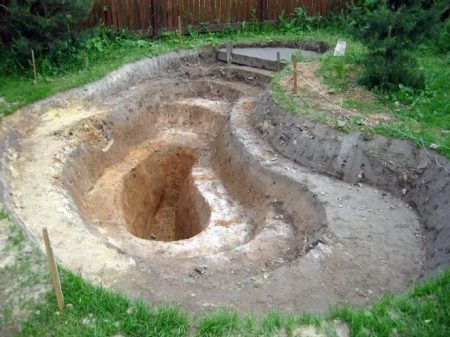
The form is chosen arbitrarily based on the tastes and preferences of the owners of the garden plot. The classic form of a decorative pond is an oval or circle; for a pond lined with tiles, a geometric shape is perfect.
The size of the pond can vary within wide limits - from a small basin buried in the ground to a large pond with an area of tens of square meters. It all depends on the desire and financial capabilities of the owners.
The larger the pond, the faster it will establish ecological balance.
The depth of the reservoir depends on its purpose. 80-100 centimeters are enough for a decorative pond, the depth of the wintering pit for a stocked pond is 150-170 centimeters. Very often the bottom of the pond is made in the form of horizontal wide steps of terraces. This is done so that plants with different immersion depths can be grown in the pond.
Pond manufacturing options from various materials
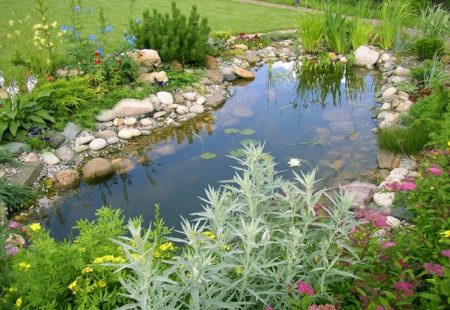
Before laying a foundation pit for a reservoir, it is necessary to determine the material and technology by which the pond will be made.The dimensions and depth of the pit, as well as the need to create a sand cushion, depend on this.
Concrete pond
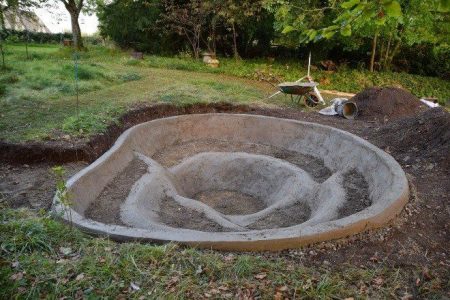
The concrete wall pond is the most complex, but also the most durable construction. Craftsmen developed two versions of the reservoir with concrete walls.
In the first embodiment, a small pond is made by digging a concrete ring into the ground. Next, either pouring the bottom of the ring with concrete followed by waterproofing the walls and the bottom, or simply lining the bottom with plastic wrap.
In the second embodiment, formwork is put on a sand cushion, a reinforcing cage is knitted and a layer of concrete is poured. Before filling the reservoir with water, the concrete bowl is covered with a waterproofing solution.
Plastic pond
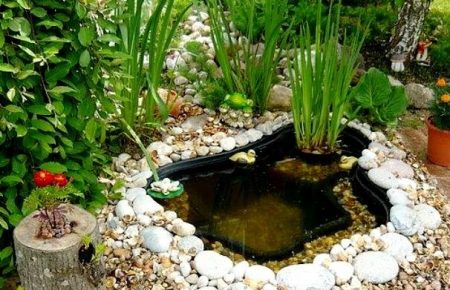
For the manufacture of the pond, many different forms are produced with a volume of 135 to 30,000 liters and a depth of 30 to 300 centimeters. Forms are available in polyethylene, polypropylene or fiberglass. Available in black, blue, green, gray and burgundy colors. The geometric shape of plastic ponds is quite diverse: there are round, rectangular, and also irregular or oval-shaped containers on sale. The service life of a pond from a plastic container can reach 30 years or more.
To install a pond from a plastic mold, dig a pit according to the size of the tank, add a sand cushion, carefully set the mold in the pit and level the top level. The gap between the soil and the mold is covered with dry sand. The pond is filled by 1/3 of the water, wait a few days until the container compacts the soil underneath and only after that fill the water to the top.
In a pond with an area of 10 square meters and a depth of 1.5-2 meters, you can breed carp fish.
PVC film pond
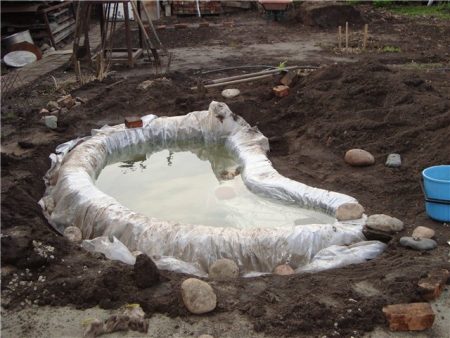
A pond made from ordinary garden film is the most budgetary solution. You can build it in just a couple of days. The film base of the pond bowl allows you to make a pond of almost any size and shape. The film is used with the maximum thickness, for the substrate under the main film using geotextiles, reinforced film or an old banner.
To make a pond from PVC films, they dig a pit, carefully remove all protruding roots and stones, add a sand cushion, then lay the film in several layers and slowly fill it with water. Water gradually fills the pond bowl, compacting the soil and stretching the film. When decorating such a reservoir, the entire surface of the film is covered with sand, soil or stones, thereby protecting the base from burnout in ultraviolet rays. Subject to this condition, the PVC film lasts up to 10 years.
The film length is calculated by the formula: pond length plus two pond depths plus 60 centimeters. The width of the film is taken equal to the width of the pond plus two pond depths plus 60 centimeters.
Butyl rubber pond
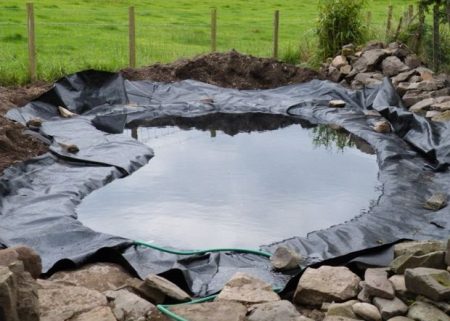
Butyl rubber film is much more expensive than ordinary garden film, but its service life reaches 40 years. The film is sold in rolls with a width of 3 to 15 meters, its thickness is from 0.5 to 2 mm. Giscolene film has a certificate of conformity and can be used in contact with food water.
Butyl rubber film does not change its texture under the influence of sunlight and does not crack from frost. When the reservoir freezes, the film can stretch 4 times, and then, when positive temperatures occur, it returns to its original state.
Butyl rubber film adheres well with special glue. It can also be glued to a vertical surface of concrete or other materials.
The technology for building ponds from butyl rubber film is similar to the technology for building ponds from PVC film.
Pond from the old bath
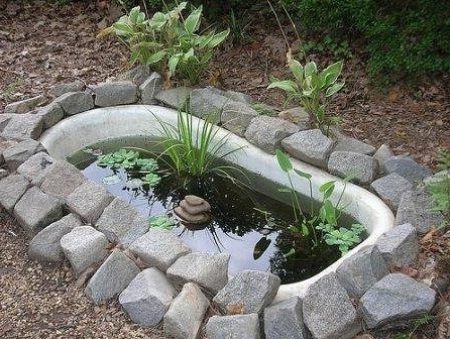
An old bathtub is a good option for making a micro-pond. For such a pond, both an acrylic and a metal bath are suitable. The pond from the bath can be made flush with the soil level or with a small depth.
To make such a pond, they dig a pit a little larger than a bathtub, add crushed stone and a sand pillow to the bottom. In the bath, plugs are inserted into the drain holes, then it is carefully placed in the pit. The space between the walls of the pit and the bathroom is covered with fine sand. The inner surface of the bath can be painted over with dark paint or simply covered with a dark film.
You can insert a hose into the lower drain hole and make a fountain in the pond.
Tire pond
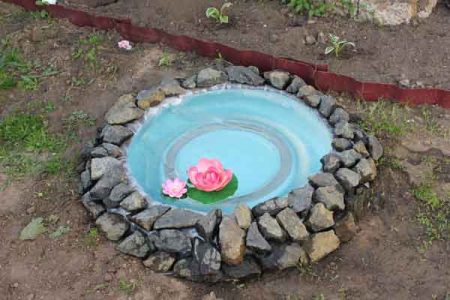
Tire pond - a fairly budget solution. The diameter and width of the tire are absolutely not important - both the tire from Oka and the rubber from Belaz are perfect for decorating the garden. The main thing is to beautifully arrange the minipond.
To make a pond from a tire do the following:
- with a jigsaw cut the sidewall from the tire;
- digging a hole in size slightly larger than the capacity;
- a sand pillow is poured into the bottom of the pit;
- gently lower the tire into the pit, fill it with loose sand at the edges;
- in the container, neatly straightening, lay the film and fill the pond with water;
- the edges of the film are fixed with earth or stones;
- decorative vegetation is planted around the perimeter of the reservoir.
Basin from the basin
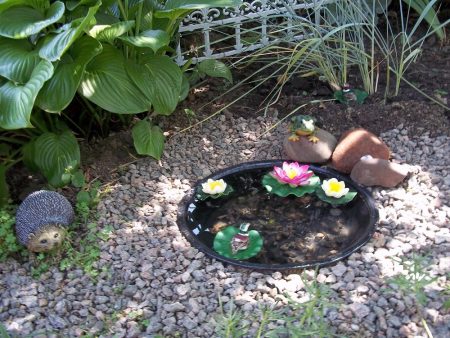
A basin from a basin is a good solution for a small garden. Arranging it takes a minimum of time, its cost is negligible, if necessary, in just a couple of hours, such a reservoir can be moved to a new place. As a basis for such a reservoir, you can use any basin, it does not matter if it is whole or full of holes, it is plastic or metal.
To make a pond from a basin, a hole is dug, a basin is buried in it, if necessary, the bottom of the basin is covered with a small piece of construction film. A pond filled with water is filled with artificial or living plants, the edges of the pelvis are decorated with stones.
Preparation of equipment and supplies
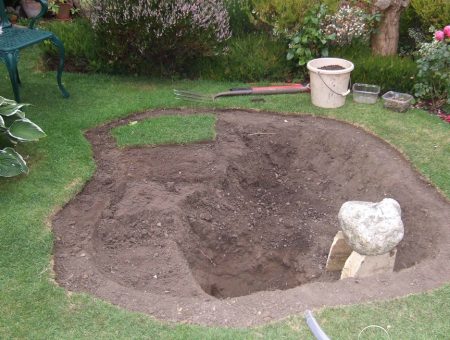
The selection of equipment for the creation and design of the pond depends on its size, the choice of materials for arranging the bowl, design options for the banks, and the presence of a fountain. For a small pond, you may need:
- marking tool. It includes tape measure, pegs, twine for contouring the excavation site of the pit;
- digging tool. The type of instrument depends on the volume of the reservoir. The pit for a micro pond from a basin can be dug out with a garden scoop; for a fish pond with a volume of ten cubic meters, it is easier to use the services of an excavator. For a medium-sized pond, a set of bayonet and shovel shovels will be universal.
- equipment for moving soil. The removed soil will need to be removed immediately from the construction site. Also, under medium and large-volume bowls, it is necessary to make sand filling. With small volumes of soil being transported, it is quite possible to dispense with garden buckets; with medium volumes, it is still preferable to use a garden trolley.
- level or (for large reservoirs) hydro level;
- a concrete mixer is required in the process of registering the coast, as well as for the manufacture of the bowl of the reservoir itself;
- a knife, scissors, a rigid ruler are necessary for working with a film;
- wrenches, plumbing tools are necessary for the device of waterfalls and fountains;
- screwdrivers, pliers, side cutters are necessary for electrical work in the design of lighting pond.
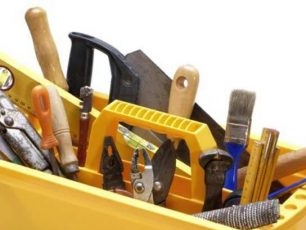
Materials for creating a pond bowl can be divided into three main groups:
- hard materials. Using a rigid body (basin, bathtub, tire, plastic container) as the basis for the pond, it is easier and faster to create a reservoir;
- flexible materials. Flexible materials include polyethylene and butyl rubber films. These materials are notable for their low price and average service life.Lining the bottom with a flexible film, you can make a pond of any shape, size and depth;
- concrete or man-made materials. The concrete bowl is the most durable, but also the most laborious to manufacture. Concrete can be purchased at a specialized enterprise or made with your own hands. For independent production of concrete, cement, sand and small gravel are acquired; plywood or boards will be required to create the formwork; the frame will require reinforcement and knitting wire or ties.
Artificial pond decoration
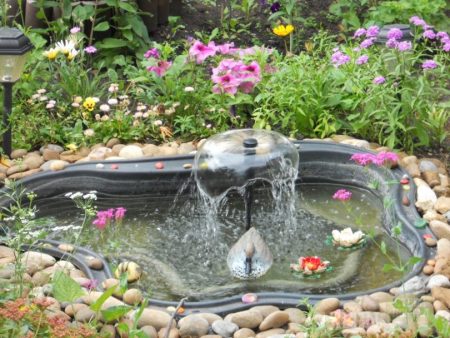
Even the smallest pond in the garden is an important functional element of landscape design. The pond will always humidify the air and change the microclimate of the site.
The land remaining after digging a pit can be rationally used by building an alpine hill near the pond.
You can “revive” a pond with a miniature fountain or waterfall. For ponds made in the form of a pool, the best solution would be fountains of a classic form, made with a lining of bronze, stone or ceramic. For ponds arranged in a forest style, waterfalls hidden in a slide made of stones will look beautiful.
Immediately after the appearance of a reservoir in the area, a place near it becomes a favorite corner of the garden. To do this, a recreation area is arranged nearby on the lawn, a table with chairs, sun loungers, a gazebo, a barbecue are installed.
To illuminate the resting place in the evening, a backlight is installed around the pond. There are a lot of lighting options: lanterns mounted on poles, searchlights, floating colored lamps - it all depends on the designer’s imagination.
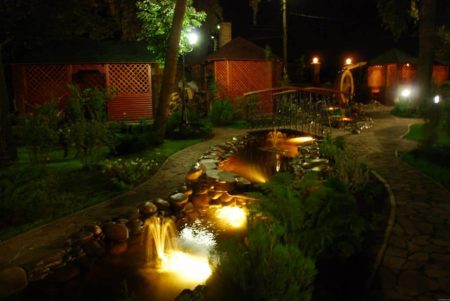
A good option for lighting - LED lamps powered by solar panels.
In the pond, aquatic plants are planted either directly in bulk soil or in pots installed on the bottom. In shallow water, cattail broadleaf, water-red coat, and white winged plants are planted. At depths of 80 centimeters, you can plant water lilies, water hyacinth, calamus, egg capsule. Ponds surrounded by a wide wooden or stone frame are decorated with flowerpots with flowering plants.
Choosing plants for the design of the near-water space, it is necessary to take into account their height and growth dynamics. A beautiful option would be to plant stunted plants near the shore: saxifrage, marsh marigold, stonecrops, reeds, fern, dwarf iris. Medium-sized plants are planted a little further away: dwarf conifers, thuja, Japanese maple, and columnar juniper.
The real decoration of the pond will be the fish floating in it. The pond can contain ornamental and ordinary fish.
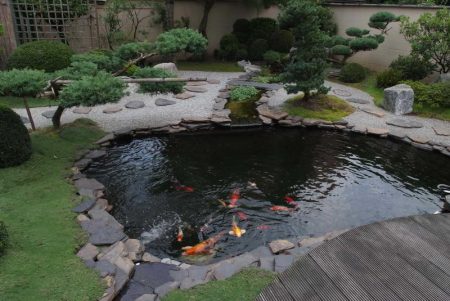
Decorative fish have a bright color and are very thermophilic. For the winter, it is better to transplant them into a warm home aquarium. Decorative pond fish include: trout, goldfish, koi carp, verkhovka, minnow.
Ordinary commercial fish winter well in artificial reservoirs 1.5–2 meters deep; they feed well and quickly. In the garden pond successfully live: carp, crucian carp, tench, bleak.
In 1 cubic meter of water in the pond, 10 to 20 small fish can live.
Artificial Pond Care
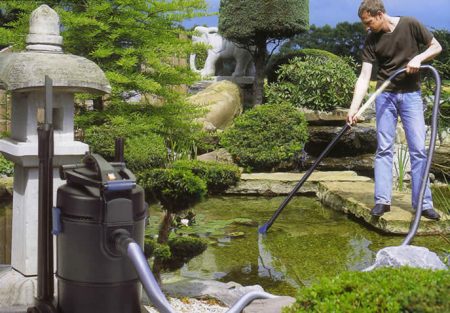
Natural reservoirs are large and therefore biological equilibrium is established in them and the water is purified without human intervention. Small ponds in garden areas require constant care and care.
All pond care work is clearly distinguished by the seasons.
Spring work:
- cleaning the pond from the remnants of autumn debris that accumulates and begins to rot at the bottom. For this, the inhabitants of the reservoir are resettled in a separate container, the water is pumped out, the bottom and walls of the reservoir are brushed. After cleaning the walls, scrub dirty water;
- after the water has settled and warmed up, an audit of the green spaces in the pond is carried out. Poorly wintered plants are removed, new ones are planted in their place. Old plants are fed and transplanted into larger pots.
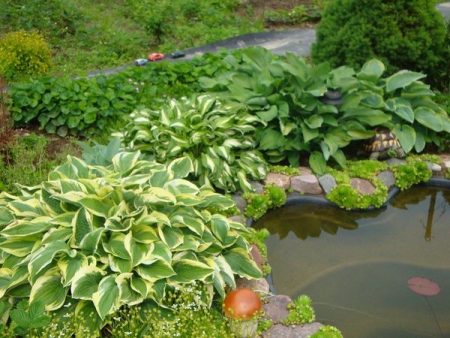
Summer work:
- in the summer in a small pond, intense evaporation of water occurs, so daily it is necessary to control the liquid level and, if necessary, add water. It is advisable to first defend the water for the pond;
- high temperature and high humidity are ideal conditions for the development and reproduction of all kinds of pests. Usually insects are fond of the trunks and leaves of coastal plants. The easiest and most environmentally friendly pest control method is to flush them with a hose jet. Insects falling into the water become food for fish, and leaves washed with a stream of water get rid of dust;
- During the whole summer season, it is necessary to regularly clean the garbage falling into the pond. For a small pond, garbage is cleaned with a net; for medium-sized ponds, a skimmer is used for these purposes.
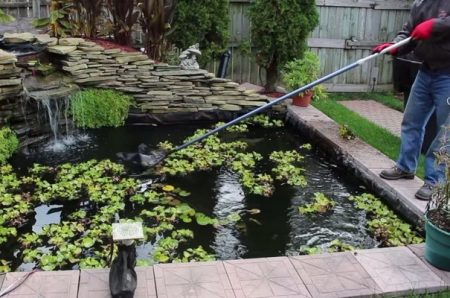 Autumn works:
Autumn works:
- The main autumn work is to protect the pond from falling leaves. To do this, the pond is regularly cleaned, and plants on the shore are cut or wrapped with a fine mesh;
- Plants from the pond are moved to an ice-free basement; fish are provided with high-calorie food to make it easier to endure the winter.
Winter work:
- ponds of shallow depth are completely drained before the most frosts. If water is not drained from the pond, then a board is placed in the center of the reservoir. Freezing water will crush soft wood without destroying the walls of the pond;
- for fish it is necessary to ensure a constant flow of oxygen. To do this, periodically drill holes in ice or put a hot pot of water on ice.
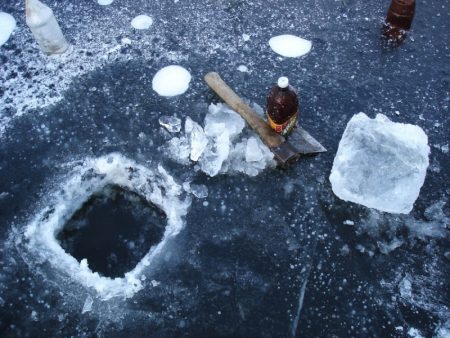
Conclusion
The Japanese proverb says "Water is the soul of the garden." A garden pond is a living organism that requires constant care and supervision, but at the same time, the reservoir literally breathes life into the surrounding landscape. Even the smallest pond makes the site special and you can no longer imagine your vacation in the garden without it.

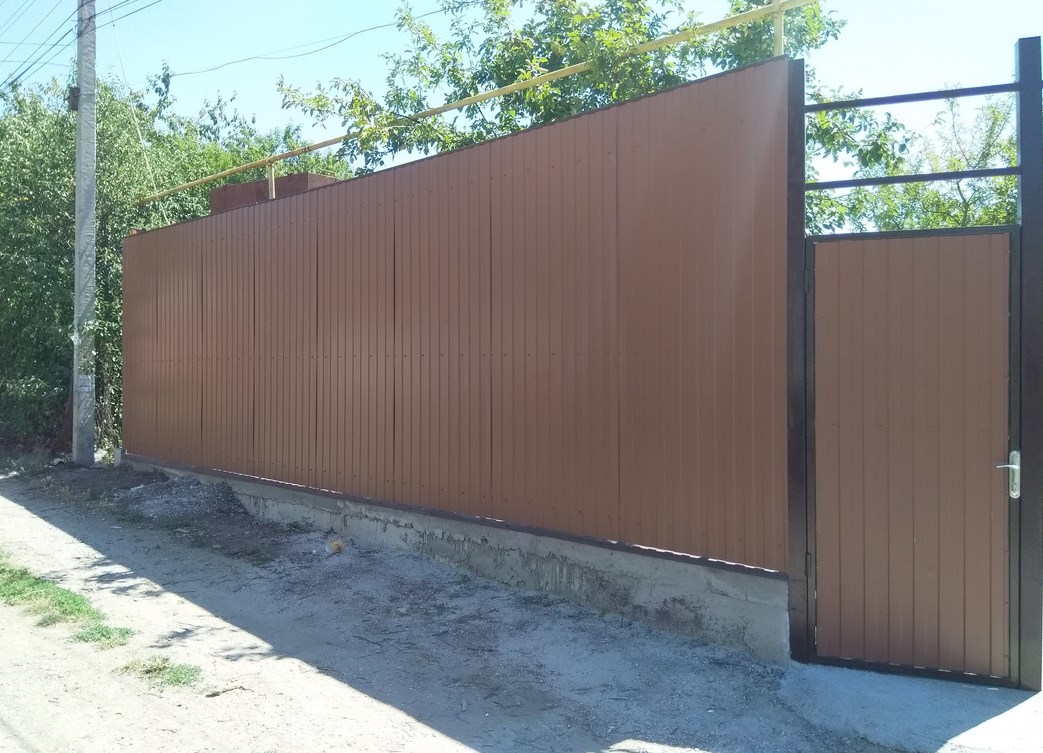
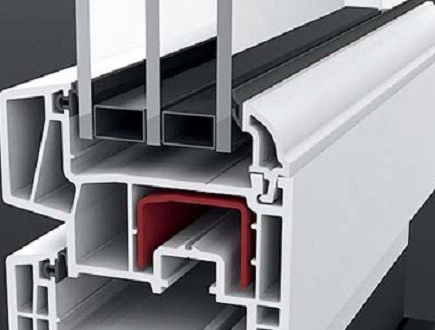
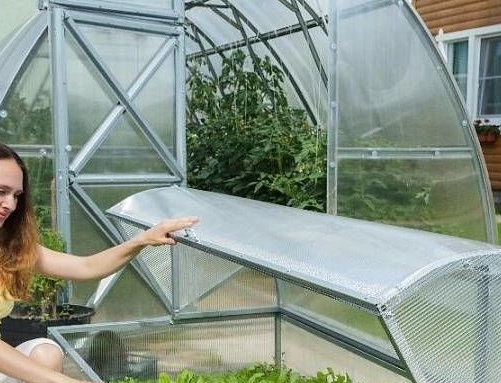
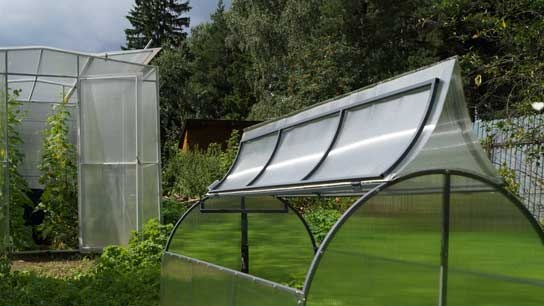 Why is a greenhouse open top?
Why is a greenhouse open top?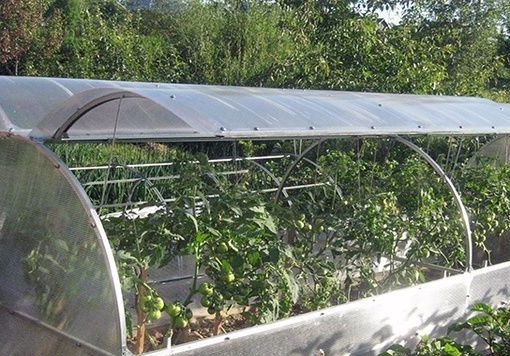 Greenhouse "Butterfly", is it worth it?
Greenhouse "Butterfly", is it worth it?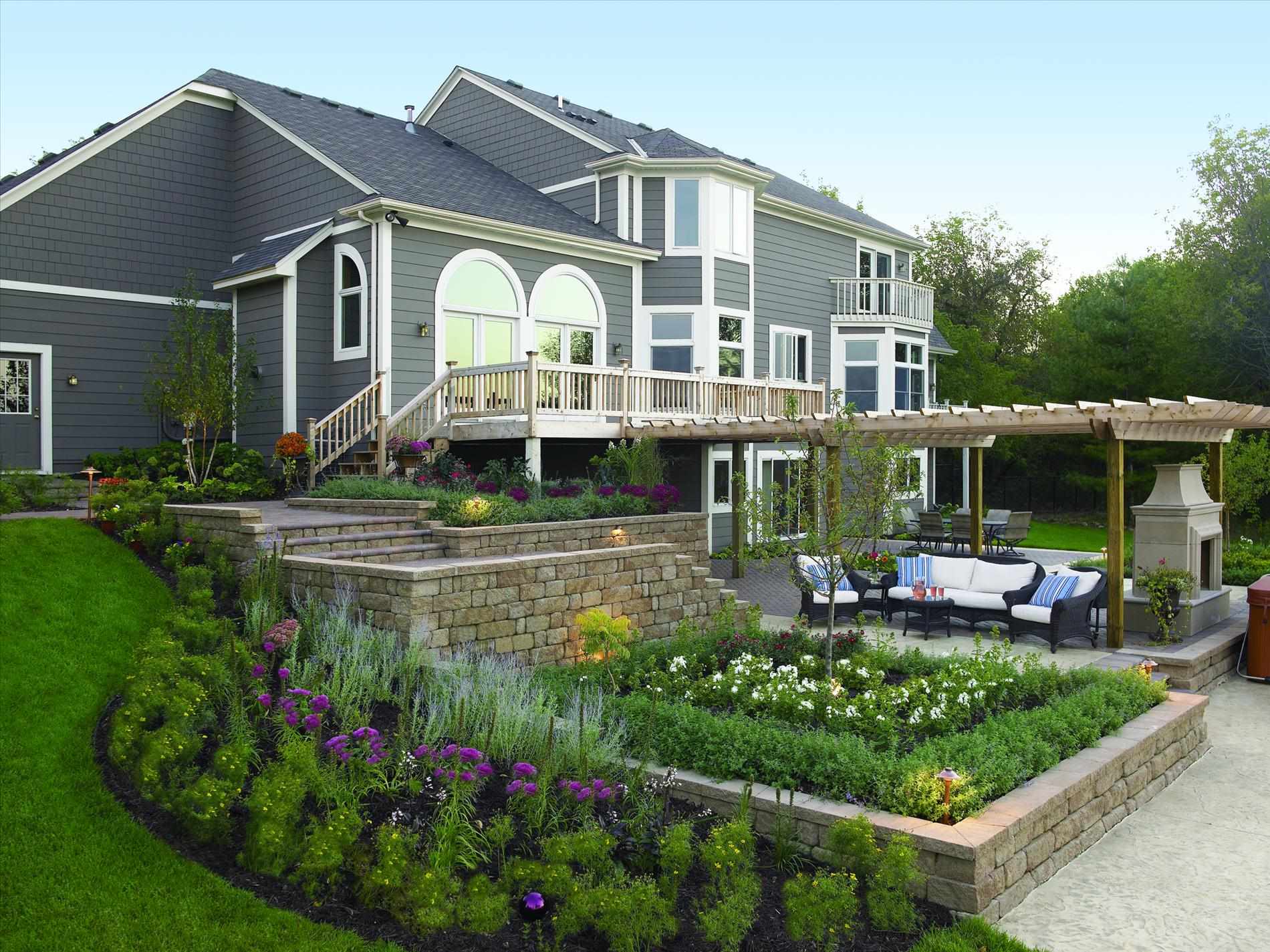 Do-it-yourself landscaping of an area of 8 acres: features of planning and zoning
Do-it-yourself landscaping of an area of 8 acres: features of planning and zoning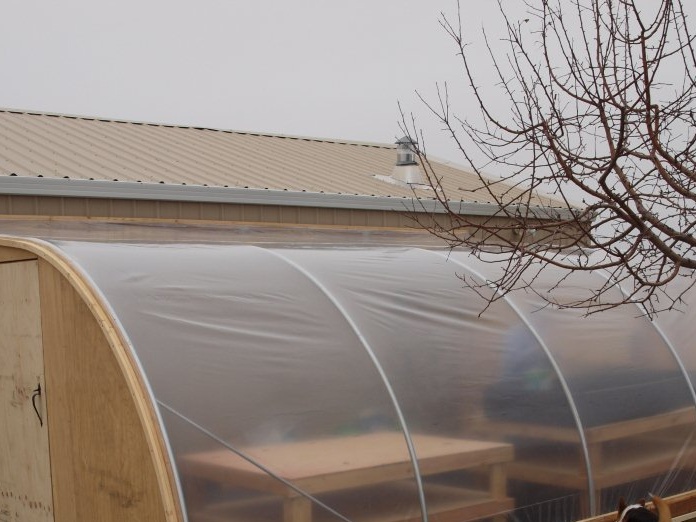 Shed greenhouse, pros and cons
Shed greenhouse, pros and cons